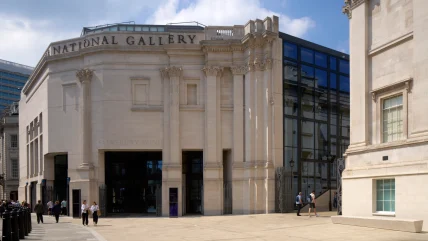
The National Gallery’s new main entrance opened to the public in May.
The renovated Sainsbury Wing will improve access for all while enhancing the public realm in Trafalgar Square.
Designed by Selldorf Architects, a New York practice led by Annabelle Selldorf, in collaboration with Purcell heritage architects, it is a key element in the £85m NG200 Welcome building programme initiated to mark the National Gallery’s 200th anniversary.
The aim throughout has been to work with the Sainsbury Wing’s original design of 1991 by Venturi, Scott Brown and Associates while improving visitor flow both within and without the building.
Selldorf said: ‘Aiming to do just what was essential to fulfil the needs of the brief – namely to function as the main entrance of the National Gallery, welcoming millions more people than in 1991 – we have opened up the sightlines, streamlined the queuing and security experience, and have brought more light across and into the space.
‘We have approached the project from a position of consideration and respect for the principles of Venturi, Scott Brown’s original design. People will feel more welcomed to come and stay and be able to orient themselves more easily in the building with its new connections to Trafalgar Square.’
The stepless street level entrance opens for all visitors from a new public square on the south-west corner of the original 1830s National Gallery building fronting Trafalgar Square. Inside, the new-look foyer that allows in daylight offers visitors 60% more open public space than before.
There are new double-height volumes to the east and west as you enter, while the first floor includes a new bookshop, restaurant and bar.
The palette of natural materials used throughout the new spaces includes the same grey Florentine limestone (pietra serena) employed in the Venturi, Scott Brown galleries along with Chamesson limestone from northern Burgundy, slate, oak and black granite. Wherever possible existing materials have been re-used, recycled or repurposed in other building projects.
Alasdair Travers, design partners at Purcell, said: ‘From a conservation architecture perspective this project is about addressing needed change while retaining the essence of what was already there. It was therefore important to us that the Sainsbury Wing still feels like itself while becoming easier to navigate for visitors. A major part of achieving this improved sense of welcome was to celebrate the bold postmodern features, like the grand staircase, making it much more legible than it was before.’
‘We all miss out when anyone thinks that the National Gallery is not for them,’ added Sir Gabriele Finaldi, director of the National Gallery. ‘Selldorf Architects’ thoughtful interventions make the gallery entrance lighter, more welcoming, and more visible as a public space. We hope many visitors may step inside for the first time, and those who have come before, can experience a different start to their visit and view of our collection.’





